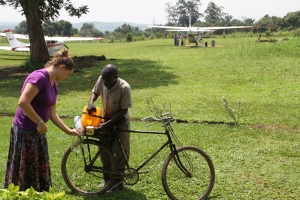I love milk. I drink glasses of it every day. I love cream. I use it in my cooking, take it in my tea, and whip it to top things. I just plain and simple love dairy, in just about every form from yogurt to cheese and everything in-between.
But as you may be catching a clue; things are different here, including dairy. A lot of missionaries when they move to the field have to give up dairy except for it in the form of powdered milk. Because I have such a love-love relationship with dairy I was determined to find a way to have fresh milk. If that meant keeping my own dairy goats for this purpose alone I would.
Living in Nyankunde comes with the huge blessing of having a dairy near by! There are people who keep milk cows and sell the milk by the cupful to others in the village and then collect an agreed-upon sum at the end of the month. The going rate here is 2 cups of milk per day, 6 days a week for about $10 US at the end of the month. We worked it out to get 4 cups a day, every week, brought to our door for $20 a month.
So we have a local guy who speaks no English or French (only Swahili) who brings us our milk every morning on his very old bike. He measures out each cup for us and pours it into the half gallon canning jar I bring outside with me. Then off he rides to the next client as I carry my precious jar of fresh milk inside.


Now I have no problem with raw milk – when I know the source that it came from and their dairy practices and hygiene-measures. But, that isn’t the case here and it has the added questions of the animal’s water-source, living conditions and the other questions of how it’s handled after that. Clean water here for drinking is a much bigger deal than in the US. So in the interest of keeping our family safe and just using common sense for the situation we are pasteurizing the milk that we receive.
Pasteurization takes time so it isn’t something I’m doing every day. I’m going to be doing it every-other day for now. Something that I will do everyday right after receiving the milk is filter it. I use a #4 reusable coffee filter to do this. This is an important step because it filters out any debris and bacteria-housing foreign objects that degrade the milk. I’m pleased to say that the milk we receive is very clean to begin with, but I wont be skipping this step; especially because I wont be pasteurizing everyday and this will help the milk stay fresh until I do get around to pasteurizing it.

I choose to use the flash-pasteurization method instead of the lower temp for longer way. Flash-pasteurization is where you gradually bring the milk up to 161 degrees F over a double-boiler and hold it at that temp for 20 seconds before cooling it as quickly as possible.



Once the milk has reached temp it needs to be cooled quickly so I had our kitchen sink full of cool water with some added ice packs from our freezer, ready to go. The milk is stirred constantly when coming up to temp and it also helps with the cooling process.

Like I mentioned earlier I love milk, but I also love cream. Cream for your tea (or coffee for the coffee drinkers out there), cream for desserts, butter, etc. So we use a cream separator to take off part of the cream leaving the equivalent of 1-2%milk. The milk will separate best if it’s still warm so after being cooled down to about 90 degrees F it’s time to run it through the separator.



The cream comes out the top spout (which we put a pint jar under) and the skimmed milk comes out the lower spout (which has my kitchen aide mixer bowl under it). You bring the separator up to full RPM before opening the valve that allows the milk into the machine and then right at the end to get as much cream as possible out of the separator you run some the skimmed milk back through the machine to flush it out.


You still want to cool the milk as quickly as possible after this process is complete so from there it’s into containers (we kept the cream in it’s jar and put the milk in a gallon-sized jar) and then those go into the fridge.

I prefer my milk cold (it’s a strong preference) so before I have any I have to let it cool. But once it’s cool I get to enjoy a wonderful cool glass of delicious milk – and that is a blessing and helps it feel more like home. Goats will probably still be in our future (heck, who knows? Maybe even a milk cow!) but for now as we get situated and figure things out for that we can still enjoy milk and the other forms of dairy I’ll be making.


Glad you found this, fresh cream – Grandpa Judd would be pleased!
LikeLike
I know! Wish he was around to know about it.
LikeLike
Thankful that you’ve found a source for dairy and know the steps/have the equipment to pasteurize the fresh milk,
LikeLike
Thanks! We planned for a home dairy with goats eventually so packed a lot of items in our shipment for that like the cream separator. It’s just a bonus that we get to use it already.
LikeLike